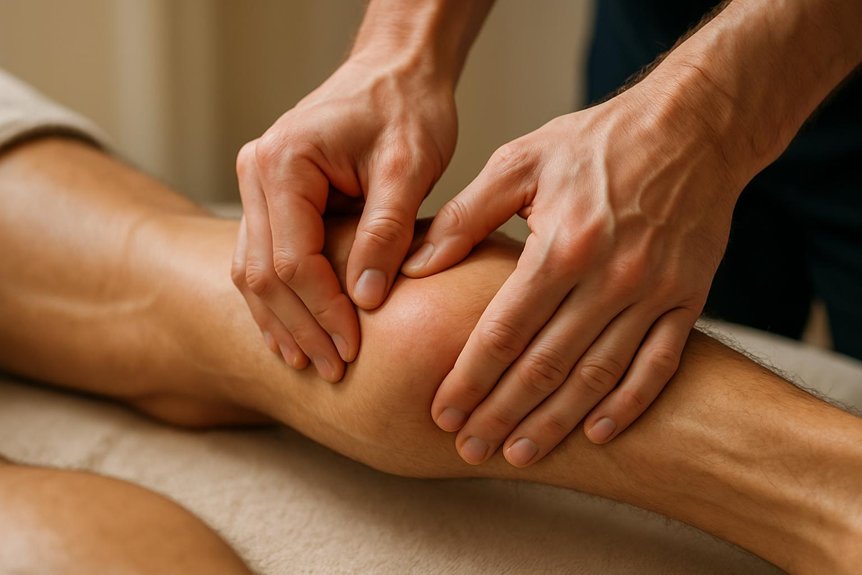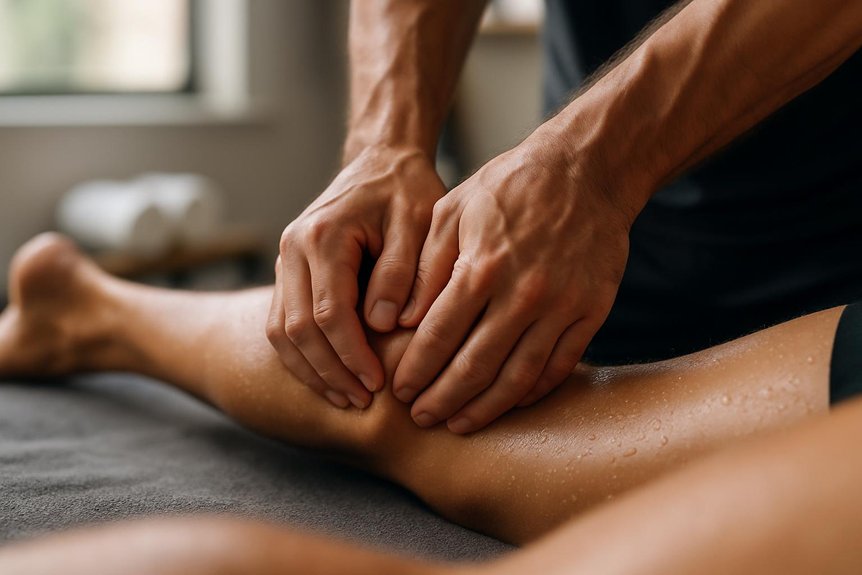Athletic massage applies graded pressure, shear, and stretch to muscles and fascia, modulating tone and restoring tissue glide. It stimulates mechanoreceptors (Ruffini, Pacinian) to reduce sympathetic drive and nociception, improving motor control. Rhythmic effleurage and targeted friction enhance capillary, venous, and lymphatic flow, clearing metabolites and delivering oxygen. Techniques such as stripping, pin‑and‑stretch, and trigger point pressure reduce adhesions and taut bands, aiding hip hinge, stride, and shoulder stability. Timing strategies optimize recovery and performance—there is more that matters.
What Sports Massage Does to Muscles and Fascia

A targeted athletic massage applies graded pressure, shear, and stretch to muscles and fascia to modulate tone, reduce nociceptive input, and restore tissue glide. In athletes, this work affects myofascial layers, intramuscular septa, and peri-neural tissues, easing stiffness without dulling strength. By stimulating mechanoreceptors—Ruffini endings, Pacinian corpuscles—therapists downregulate sympathetic drive and calm guarding.
Local circulation increases, clearing metabolites while delivering oxygen to fatigued fibers.
At Spa & Massage in London, therapists map tension lines along kinetic chains—calf to hamstring to glute—to address load-sharing, not just sore spots. They respect fiber orientation, sliding across adhesions to rehydrate the extracellular matrix and improve tendon excursion. Clients report easier hip hinge, freer stride, steadier shoulders—quiet, efficient movement that holds under pressure.
Athletic massage can be complemented by Reflexology techniques that target specific points on the feet, encouraging a holistic healing response throughout the entire body.
Techniques Our Therapists Use and Why They Work
While tailoring treatment to sport and training phase, Spa & Massage therapists deploy a concise toolkit—slow myofascial release, longitudinal and cross‑fiber friction, active and passive muscle stripping, pin‑and‑stretch, neuromuscular (trigger point) techniques, and joint‑aware mobilisations—selected for specific tissue and neural effects.
Slow fascial work glides along fascial lines to reduce densification around the IT band, calf, or paraspinals.
Friction targets adhesions at tendon–muscle junctions, useful for rotator cuff or hamstring insertions.
Stripping follows fibre direction to unload taut bands, while pin‑and‑stretch lengthens tissues under tension through comfortable ranges.
Trigger point pressure desensitises hyperirritable loci in levator scapulae, piriformis, or soleus.
Joint‑aware mobilisations coordinate soft tissue with scapulothoracic, hip, or ankle mechanics.
In our London clinics, pressure and pacing stay conversational, precise, and goal‑led.
The Science: Circulation, Nervous System, and Recovery
Though athletic massage is often described in broad terms, its effects can be traced to specific physiological mechanisms relevant to training and competition. At Spa & Massage, therapists target vascular and neural pathways to support performance.
Rhythmic effleurage increases capillary perfusion, enhancing oxygen delivery and metabolite clearance in working muscles. Focused petrissage and friction mobilise fascia, improve venous and lymphatic return, and reduce local edema.
Neurophysiologically, graded pressure modulates nociception via spinal gating and stimulates mechanoreceptors that downshift sympathetic tone, easing protective muscle guarding. This parasympathetic tilt can normalise resting muscle tension and improve motor control.
Recovery benefits include decreased delayed-onset muscle soreness, improved range of motion, and restoration of tissue glide.
In our clinics, therapists calibrate depth and tempo to the athlete’s tissue response, maintaining precise, informed touch.
When to Book: Timing Around Training and Events
Timing matters: a light, fast pre-event athletic massage 24–48 hours before competition can prime neuromuscular activation without provoking DOMS.
The ideal post-event window is within 2–24 hours, using gentle flushing and myofascial techniques to reduce edema, restore tissue gliding, and calm sympathetic drive.
Across the training cycle, therapists at Spa & Massage adjust pressure, frequency, and focus—heavier work in base phases, maintenance during peak weeks, and recovery-focused sessions after high-load days—to support performance and reduce injury risk.
Pre-Event Performance Prep
Before a race or match, ideal massage timing aligns with the athlete’s training load, recovery cycles, and nervous system arousal. Evidence supports scheduling stimulating athletic massage 24–48 hours pre-event: shorter, lighter-pressure strokes, brisk effleurage, and targeted friction to prime motor units without provoking soreness.
Focus narrows to key chains—calves–hamstrings–gluteals, hip flexors, thoracolumbar fascia, and scapular stabilisers—to optimise muscle-tendon compliance and joint play.
At Spa & Massage, therapists calibrate touch to the athlete’s arousal state: parasympathetic-leaning clients receive slightly faster pacing to lift alertness; over-amped clients get slower rhythms to lower tone without sedation.
Myofascial gliding over ITB borders, tibialis posterior, and plantar fascia refines proprioception.
Session length stays concise (20–30 minutes), avoiding deep stripping or novel techniques that could disrupt readiness.
Post-Event Recovery Window
An effective post-event recovery window starts once acute inflammation stabilises and neuromuscular fatigue is evident—typically 6–24 hours after competition for light recovery work, and 24–72 hours for deeper tissue interventions.
In this window, gentle, rhythmical flushing promotes venous and lymphatic return, reduces interstitial oedema, and restores parasympathetic tone.
As DOMS peaks around 24–48 hours, graded pressure along the kinetic chain—calves to hamstrings to gluteal complex—addresses adhesions without provoking flare-ups.
Spa & Massage therapists in London schedule athlete-focused sessions accordingly: early light sessions emphasise diaphragmatic breathing, passive mobilisations, and superficial fascial glides.
Later sessions progress to slow, specific myofascial release and cross-fibre frictions at the musculotendinous junctions.
Hydration, a brief walk, and gentle loaded range (e.g., heel raises, hip hinging) are recommended to consolidate tissue perfusion and maintain neuromuscular coherence.
Training Cycle Integration
For athletes periodising training, athletic massage is most effective when aligned with specific phases: accumulation, intensification, taper, and post-event recovery.
During accumulation, firmer techniques target fascial adhesions and stiff myofascia in prime movers—calves, hamstrings, glutes, and thoracolumbar fascia—scheduled 24–48 hours after heavy sessions.
Through intensification, shorter, region-specific work reduces trigger point irritability in the rotator cuff, hip external rotators, and plantar flexors, typically midweek to preserve neural freshness.
In taper, gentler, rhythmical strokes optimise parasympathetic tone, venous return, and lymphatic flow, booked 3–5 days pre‑event.
Within 2–24 hours post‑event, light flushing and diaphragm release aid oedema clearance and restore ribcage mobility.
At Spa & Massage, therapists sequence pressure, pace, and breath cues to fit each athlete’s microcycle.
What to Expect in a Session at Spa & Massage
At Spa & Massage, each athletic massage begins with a concise consultation and movement assessment to map symptom patterns, training load, and tissue irritability.
Therapists then apply targeted techniques—such as myofascial release, longitudinal and cross-fiber friction, trigger point compression, and contract–relax stretching—modulating pressure to the athlete’s tolerance and the tissue’s stage of recovery.
Sessions conclude with evidence-based aftercare: hydration guidance, load management advice, local mobility drills, and timing for heat, cold, or self-massage to optimise recovery.
Consultation and Assessment
How does an effective athletic massage session begin? At Spa & Massage, it starts with a concise, private consultation. The therapist reviews training load, injury history, sleep, nutrition, and red flags. They clarify goals—accelerated recovery, pre-event priming, or post-injury support—and obtain informed consent.
Assessment follows: posture, gait, joint range, and targeted orthopedic screens. Palpation maps tissue tone, fascial glide, trigger points, and tenderness along kinetic chains—calf to hamstring, hip rotators to lumbar fascia, scapular stabilisers to cervical extensors.
Neuromuscular tests explore inhibition or overrecruitment, while pain provocation differentiates contractile from joint or neural sources.
Findings guide a focused plan—priority regions, session sequencing, and tolerance thresholds. Athletes leave this stage feeling seen, with clear objectives aligned to their event calendar and recovery windows.
Techniques and Pressure
Although goals vary by sport and event phase, a typical session employs calibrated soft-tissue techniques matched to tissue depth and irritability.
At Spa & Massage, therapists modulate pressure by layer: light effleurage warms skin and superficial fascia; moderate petrissage mobilises muscle bellies; deeper, slow strokes follow fibre orientation to influence trigger points and adhesions without provoking guarding.
Joint-friendly techniques—pin-and-stretch, friction across tendons, and myofascial release—are applied to specific structures such as the iliotibial tract, paraspinals, rotator cuff, and calf complex.
Pressure is titrated using a 0–10 comfort scale and palpatory feedback: tissue yield, temperature, and tone guide increments.
Breath cueing maintains parasympathetic balance.
Sessions focus on prime movers and synergists relevant to the athlete’s discipline, preserving range while respecting pain boundaries.
Aftercare and Recovery
Following calibrated soft-tissue work and joint-friendly techniques, recovery protocols are set to consolidate gains in mobility and reduce post-treatment soreness. At Spa & Massage, therapists explain expected sensations—transient heaviness, warmth, or DOMS-like tenderness—as local circulation and lymphatic clearance increase.
Clients are guided to hydrate, prioritising electrolytes to support fascial glide and neuromuscular recovery.
Targeted self-care is prescribed: gentle active range-of-motion, diaphragmatic breathing to downshift sympathetic drive, and contrast hydrotherapy for microvascular flushing.
Where appropriate, our therapists advise 24–48 hours before high-intensity loading of treated tissues, easing back with technique drills and submaximal work. For irritated tendons or DOMS-prone groups, they may suggest isometrics and light eccentrics.
In our clinics, hypoallergenic oils are used; post-session, clients can shower after one hour to retain dermal nourishment. Follow-up timing is tailored to training cycles.
Benefits for Performance, Mobility, and Injury Prevention
When integrated into training cycles, athletic massage can enhance force production, movement efficiency, and tissue resilience by targeting specific neuromuscular mechanisms. By modulating muscle spindle sensitivity and Golgi tendon organ thresholds, therapists reduce excessive tone in overactive fibres while reinforcing ideal motor recruitment.
Focused stripping along the muscle belly and cross-fibre friction at the musculotendinous junctions help restore fascial glide, improving sarcomere length uniformity and joint range.
Athletes often see cleaner mechanics: hip extension becomes fuller, scapular upward rotation more coordinated, and ankle dorsiflexion less restricted—each translating to more economical stride, stroke, or lift.
At Spa & Massage, protocols prioritise high-load tissues—calves, hamstrings, hip rotators, lats, and forearm flexors—while screening for trigger points and adhesions. This targeted care mitigates overload patterns, lowering risk of tendinopathy, strains, and compensatory joint irritation.
Aftercare and How to Maximise Results Between Sessions
Stronger mechanics and reduced tone are only maintained if tissues recover and adapt appropriately after the session. Spa & Massage therapists advise 24–48 hours of graded loading: easy aerobic work, then light mobility drills.
Hydration supports interstitial fluid clearance; aim for pale urine. Post-massage soreness reflects transient nociceptor sensitisation—apply gentle heat, not aggressive stretching, for the first evening.
To consolidate gains, they prescribe precise self-care: diaphragmatic breathing to downshift sympathetic drive; targeted isometrics to stiffen tendons without provoking DOMS; and mobility for hips, thoracic spine, and ankles to preserve end-range access. Sleep remains the premier recovery tool.
Between sessions, our clinicians recommend trigger point balls sparingly, peroneal and calf eccentric work for runners, and posterior-chain activation for field athletes. Rebook cadence: every 1–3 weeks during heavy blocks.
Conclusion
In the quiet after training, athletic massage becomes a metronome—resetting rhythm in tissue and tone in the nervous system. Each stroke is a calibrated signal: flushing metabolites, easing trigger points, lengthening fascia along lines of force. Like tuning a racing shell, small adjustments yield efficient glide—better joint tracking, cleaner motor patterns, reduced injury risk. Athletes leave with clear cues for hydration, mobility, and load management, carrying forward a compass of recovery that points them reliably toward performance.



